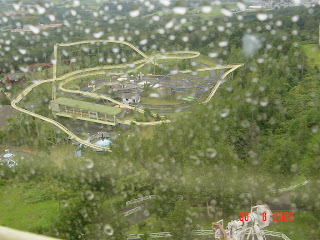
The basics of the art of throwing in Taiji can be illustrated by the
ring children.
1. It involves the centre - the eye of the ring.
2. It involves circular movement - the outer ring.
3. It involves balancing - the turning babies.
4. It involves the joints - the folding arms, bodies and legs.
5. It involves the technique of Yin and Yang - the boy and the girl.
6. It should be used on solid ground - where the statue stands.
Comparing taiji with other schools with throwing applications, there is no big difference in the "forms" used. The difference lies in the way as to how an opponent is unbalanced before he is thrown.
Apart from
Yin Yang Conversion, one of the techniques used in Taiji is the applying of a slight force on a critical joint of the opponent so that his centre of gravity is altered. The opponent can then be thrown without using strength. Many "beginners" are fascinated by such "magical touch".
Not relying on brutish force, such application technique should be supported by the body condition acquired through the
basic trainings. Without the support of a natural body, this technique is only workable in demonstrations (for
art appreciation) and not in a contest.
Applying a slight force on a critical joint of your opponent is the final touch before a throw. Prior to this, you have to slip (not break, hence, not brutish pushes or pulls) into the defensive ring of the opponent, attach to him, cross the bridge, take over the centre, and convert the Yin and Yang. These should be done in one go. In fact, once you convert the Yin and Yang, you can almost do anything on your opponent. The importance of the joint movement should not be over-emphasised.
In a real deal, no one will let you do the final touch freely on him as you can do so in a demonstration where your partner "cooperates" with you. Without the flexibility, sensitivity and power of a natural body, it is difficult to unbalance an opponent, in accordance with the taiji principles, in a real deal. It is therefore essential that a practitioner gets the basics correct from the very beginning of his training.
Not knowing the importance of and the rationales behind the basic trainings, many "beginners" (in the sense of knowledge, not seniority) find it difficult, if not impossible, to throw an opponent without using brutish force in a confronted situation. They end up doing weight lifting at the gym, condemning the Taiji Classic as a piece of nonsense.
 Another wonderful morning at Prague.
Another wonderful morning at Prague.





.jpg)















